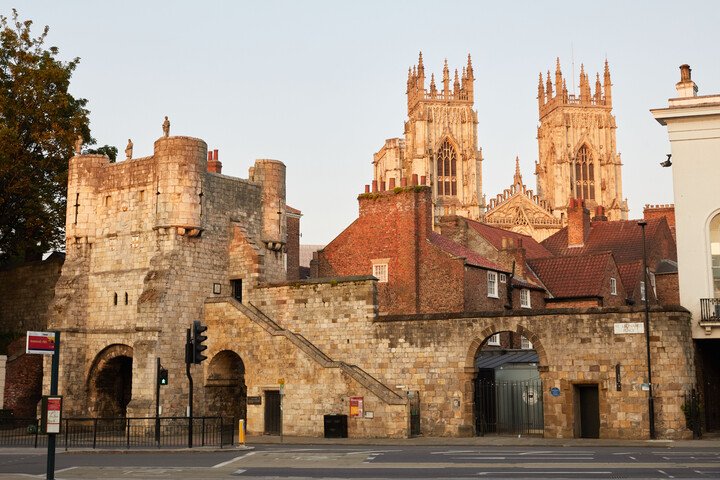Bootham Bar is one of the four principal medieval gateways—known as “bars”—integrated into York’s historic city walls. Situated at the northern entrance to the city, it has served as a critical point of defense, trade, and administration for over two millennia. Its layered history, architectural evolution, and enduring presence make it a significant monument reflecting York’s rich past.
Historical Origins
The site of Bootham Bar has been a gateway into York since Roman times. It stands near the location of the Roman fortress Eboracum’s northwestern gate, known as the porta principalis dextra. Archaeological evidence confirms that Roman remains are visible beneath the current structure, indicating continuous use of this entry point for nearly 2,000 years.
The name “Bootham” derives from the Old Norse term “Buðum,” meaning “at the booths,” reflecting the presence of market stalls and small houses for craftsmen along this major northern route. This area was historically significant for trade and commerce, serving travelers and merchants entering the city.
Architectural Evolution
The earliest surviving stonework of Bootham Bar dates back to the 11th century, with significant additions and modifications occurring in the 14th and 19th centuries. The structure features a three-storey stone tower constructed from gritstone and magnesium limestone, materials commonly used in the region. In the 14th century, the bar was heightened to accommodate a portcullis and a barbican—a fortified outpost or gateway—was added to enhance its defensive capabilities.
The barbican, projecting out to the northwest, was the last of York’s bars to be removed, demolished in 1835 to improve access to the newly constructed St Leonard’s Place.
Functional Significance
Throughout its history, Bootham Bar has served multiple roles:
- Defense: As a fortified gateway, it was integral to the city’s medieval defenses, controlling access and providing a stronghold against potential invaders.
- Trade Regulation: The bar functioned as a toll gate, with records from 1280 indicating the collection of tolls from those entering the city.
- Judicial Symbolism: In the 14th and 15th centuries, Bootham Bar was used to display the heads of executed traitors, including Thomas Mowbray, Earl of Norfolk, serving as a grim warning to others.
Interactions with St. Mary’s Abbey
Bootham Bar’s proximity to St. Mary’s Abbey led to a complex relationship between the city’s authorities and the abbey. The abbey held the right to conduct a weekly market near the bar, a privilege that sometimes caused friction with city officials over jurisdiction and economic control. In 1354, an agreement was reached wherein the city acknowledged the abbey’s access to Bootham, while the abbey recognized the city’s authority over the area, illustrating the negotiated balance of power.
Preservation and Modern Significance
Today, Bootham Bar stands as a Grade I listed building and a Scheduled Monument, reflecting its national historical and architectural importance. It remains a prominent feature of York’s city walls, offering visitors a tangible connection to the city’s layered past. The bar is accessible to the public, allowing for exploration of its historical features and providing panoramic views of the surrounding area.
Conclusion
Bootham Bar encapsulates the rich tapestry of York’s history, from its Roman origins through medieval transformations to its current status as a preserved historical monument. Its enduring presence offers insight into the city’s evolution, serving as a testament to York’s resilience and the importance of preserving such structures for future generations.

